Case Law: Examining the Equality Act 2010 and Workplace Discrimination
VerifiedAdded on 2019/09/30
|11
|1684
|360
Case Study
AI Summary
This case study analyzes a scenario involving race discrimination in the workplace, focusing on the Equality Act 2010. It examines the legal framework, particularly Section 9, which addresses discrimination based on race, nationality, and ethnic origin. The assignment discusses the risks associated with race discrimination, including potential penalties and compensation for victims, referencing the case of NHS Foundation Trust. It provides recommendations for organizations to ensure legal compliance and prevent future incidents, such as promoting equality, minimizing discrimination risks, and managing cultural differences. The analysis concludes that the employee, Raj, has been discriminated against based on his nationality and highlights the employer's responsibilities to address the issue and avoid legal repercussions. The assignment provides an overview of the Equality Act, workplace discrimination, and the importance of creating a fair and inclusive work environment. It includes references to relevant case law, legislation, and guidelines.

Running head: case law
law and equality at work
Case law
law and equality at work
Case law
Paraphrase This Document
Need a fresh take? Get an instant paraphrase of this document with our AI Paraphraser
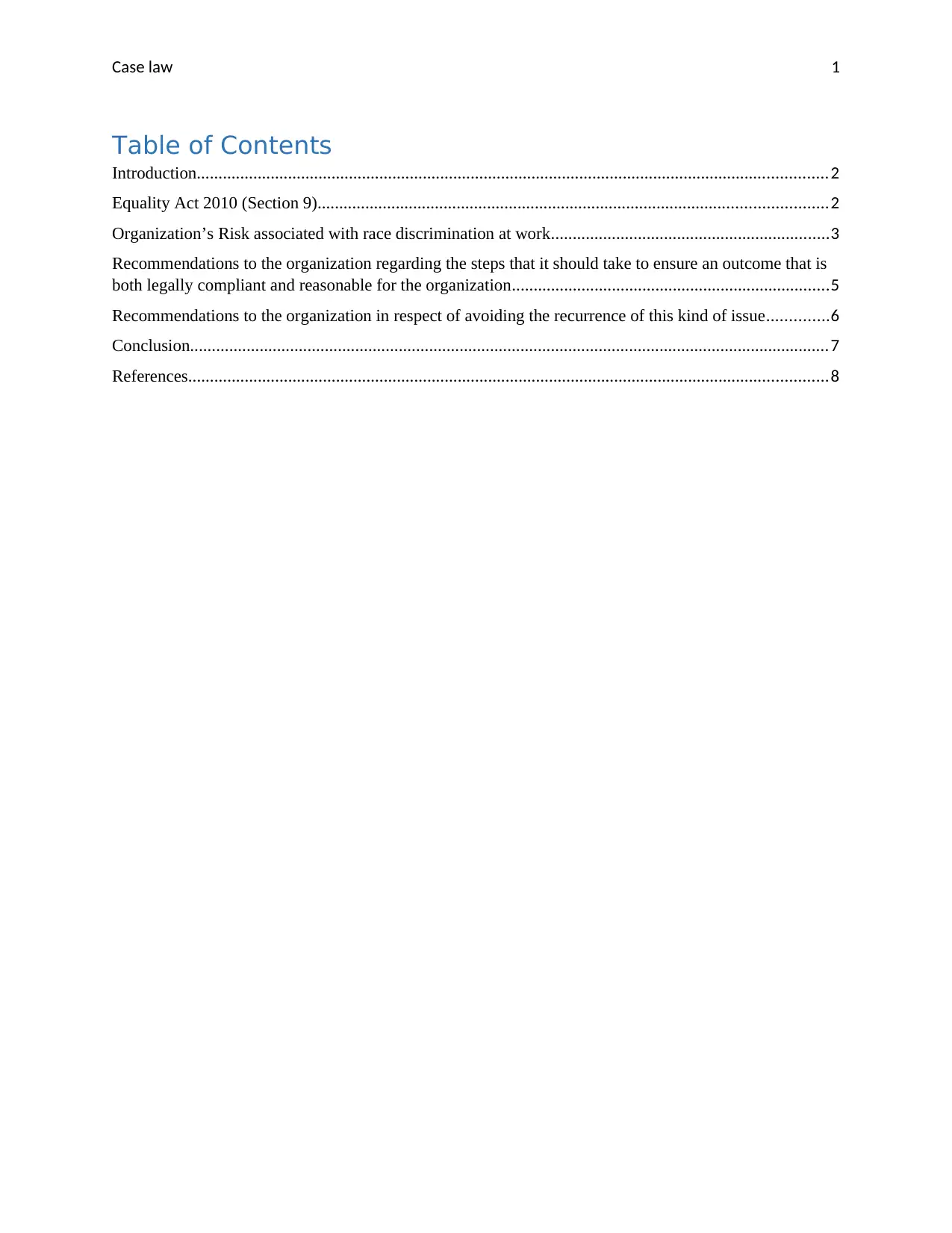
Case law 1
Table of Contents
Introduction.................................................................................................................................................2
Equality Act 2010 (Section 9).....................................................................................................................2
Organization’s Risk associated with race discrimination at work................................................................3
Recommendations to the organization regarding the steps that it should take to ensure an outcome that is
both legally compliant and reasonable for the organization.........................................................................5
Recommendations to the organization in respect of avoiding the recurrence of this kind of issue..............6
Conclusion...................................................................................................................................................7
References...................................................................................................................................................8
Table of Contents
Introduction.................................................................................................................................................2
Equality Act 2010 (Section 9).....................................................................................................................2
Organization’s Risk associated with race discrimination at work................................................................3
Recommendations to the organization regarding the steps that it should take to ensure an outcome that is
both legally compliant and reasonable for the organization.........................................................................5
Recommendations to the organization in respect of avoiding the recurrence of this kind of issue..............6
Conclusion...................................................................................................................................................7
References...................................................................................................................................................8
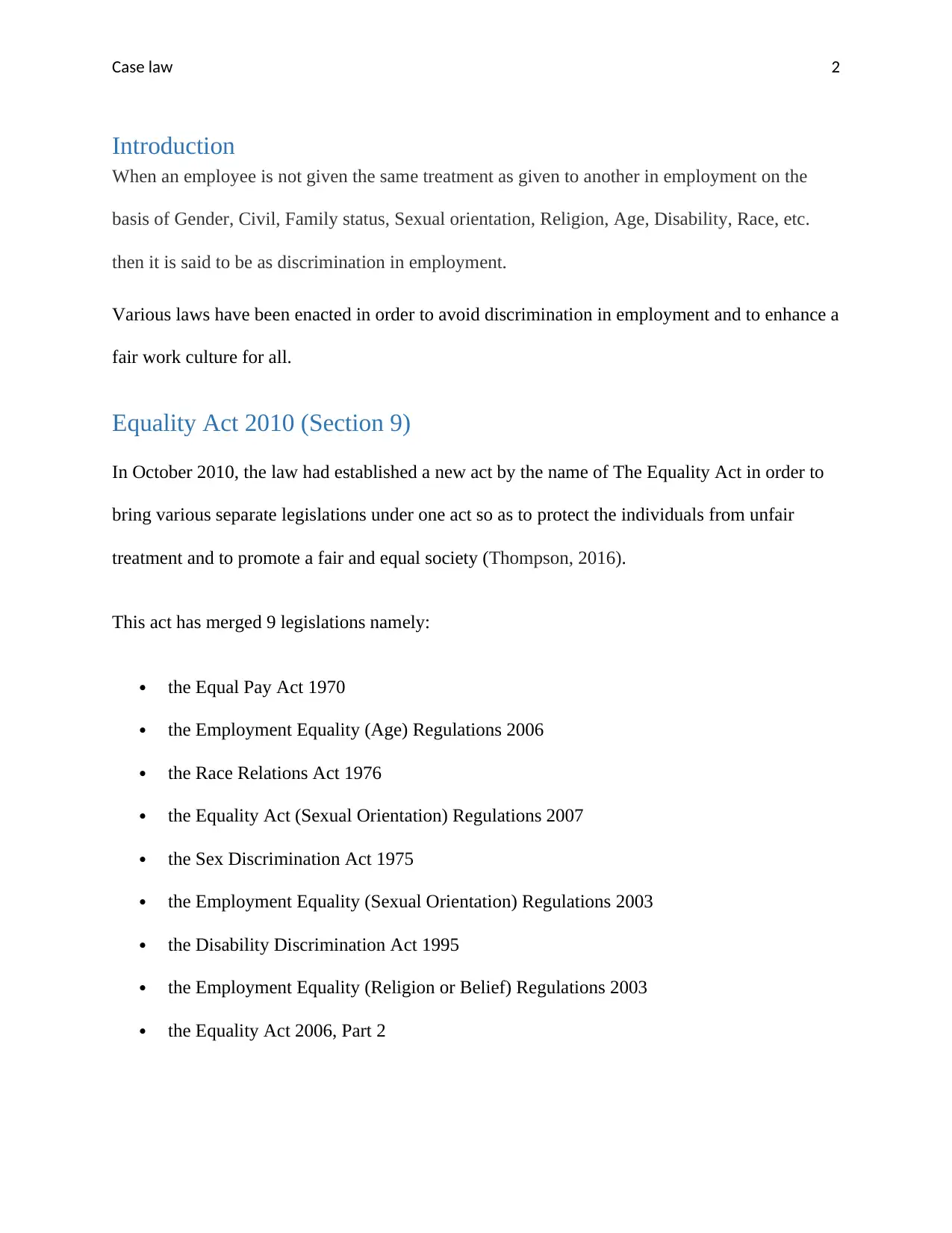
Case law 2
Introduction
When an employee is not given the same treatment as given to another in employment on the
basis of Gender, Civil, Family status, Sexual orientation, Religion, Age, Disability, Race, etc.
then it is said to be as discrimination in employment.
Various laws have been enacted in order to avoid discrimination in employment and to enhance a
fair work culture for all.
Equality Act 2010 (Section 9)
In October 2010, the law had established a new act by the name of The Equality Act in order to
bring various separate legislations under one act so as to protect the individuals from unfair
treatment and to promote a fair and equal society (Thompson, 2016).
This act has merged 9 legislations namely:
the Equal Pay Act 1970
the Employment Equality (Age) Regulations 2006
the Race Relations Act 1976
the Equality Act (Sexual Orientation) Regulations 2007
the Sex Discrimination Act 1975
the Employment Equality (Sexual Orientation) Regulations 2003
the Disability Discrimination Act 1995
the Employment Equality (Religion or Belief) Regulations 2003
the Equality Act 2006, Part 2
Introduction
When an employee is not given the same treatment as given to another in employment on the
basis of Gender, Civil, Family status, Sexual orientation, Religion, Age, Disability, Race, etc.
then it is said to be as discrimination in employment.
Various laws have been enacted in order to avoid discrimination in employment and to enhance a
fair work culture for all.
Equality Act 2010 (Section 9)
In October 2010, the law had established a new act by the name of The Equality Act in order to
bring various separate legislations under one act so as to protect the individuals from unfair
treatment and to promote a fair and equal society (Thompson, 2016).
This act has merged 9 legislations namely:
the Equal Pay Act 1970
the Employment Equality (Age) Regulations 2006
the Race Relations Act 1976
the Equality Act (Sexual Orientation) Regulations 2007
the Sex Discrimination Act 1975
the Employment Equality (Sexual Orientation) Regulations 2003
the Disability Discrimination Act 1995
the Employment Equality (Religion or Belief) Regulations 2003
the Equality Act 2006, Part 2
⊘ This is a preview!⊘
Do you want full access?
Subscribe today to unlock all pages.

Trusted by 1+ million students worldwide
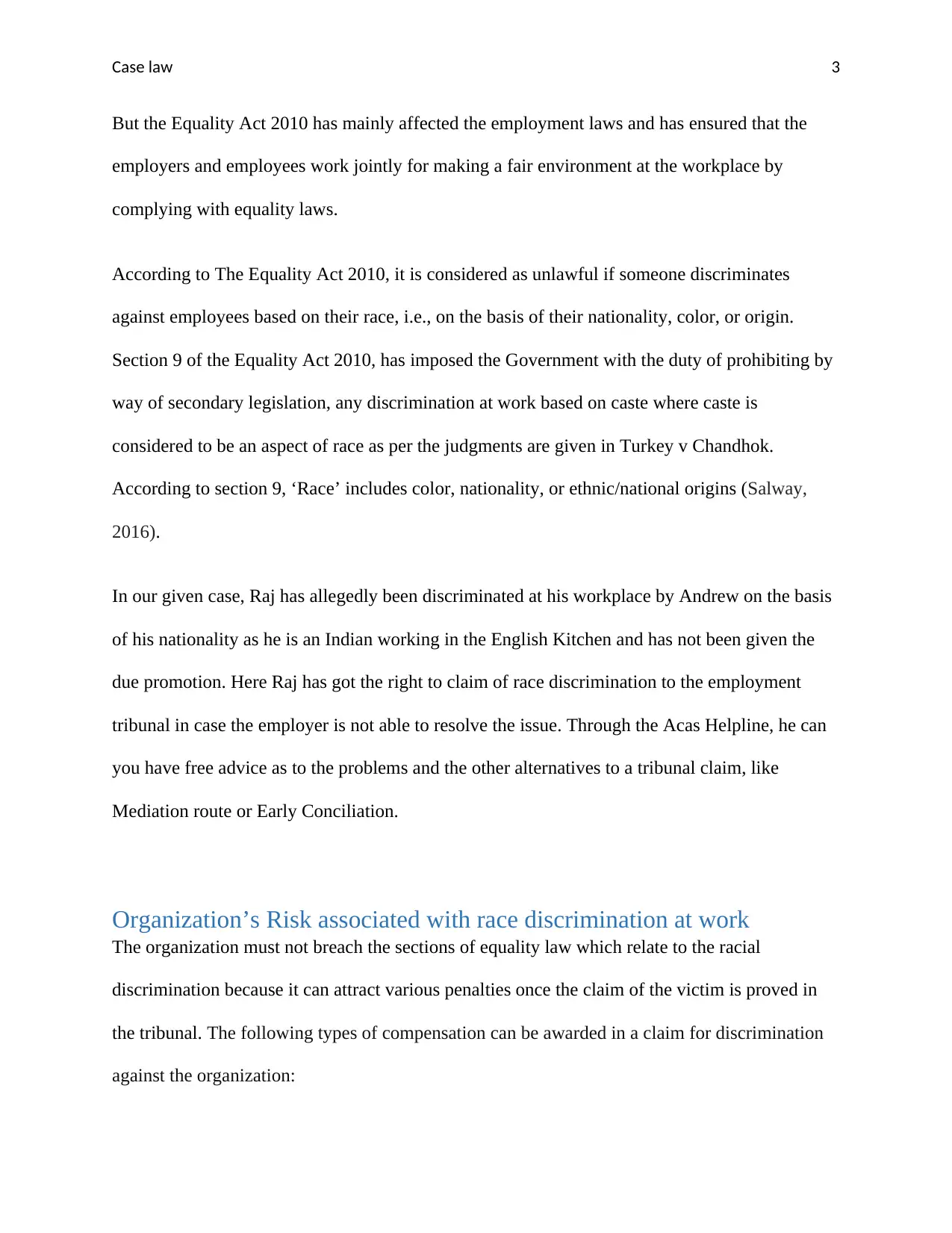
Case law 3
But the Equality Act 2010 has mainly affected the employment laws and has ensured that the
employers and employees work jointly for making a fair environment at the workplace by
complying with equality laws.
According to The Equality Act 2010, it is considered as unlawful if someone discriminates
against employees based on their race, i.e., on the basis of their nationality, color, or origin.
Section 9 of the Equality Act 2010, has imposed the Government with the duty of prohibiting by
way of secondary legislation, any discrimination at work based on caste where caste is
considered to be an aspect of race as per the judgments are given in Turkey v Chandhok.
According to section 9, ‘Race’ includes color, nationality, or ethnic/national origins (Salway,
2016).
In our given case, Raj has allegedly been discriminated at his workplace by Andrew on the basis
of his nationality as he is an Indian working in the English Kitchen and has not been given the
due promotion. Here Raj has got the right to claim of race discrimination to the employment
tribunal in case the employer is not able to resolve the issue. Through the Acas Helpline, he can
you have free advice as to the problems and the other alternatives to a tribunal claim, like
Mediation route or Early Conciliation.
Organization’s Risk associated with race discrimination at work
The organization must not breach the sections of equality law which relate to the racial
discrimination because it can attract various penalties once the claim of the victim is proved in
the tribunal. The following types of compensation can be awarded in a claim for discrimination
against the organization:
But the Equality Act 2010 has mainly affected the employment laws and has ensured that the
employers and employees work jointly for making a fair environment at the workplace by
complying with equality laws.
According to The Equality Act 2010, it is considered as unlawful if someone discriminates
against employees based on their race, i.e., on the basis of their nationality, color, or origin.
Section 9 of the Equality Act 2010, has imposed the Government with the duty of prohibiting by
way of secondary legislation, any discrimination at work based on caste where caste is
considered to be an aspect of race as per the judgments are given in Turkey v Chandhok.
According to section 9, ‘Race’ includes color, nationality, or ethnic/national origins (Salway,
2016).
In our given case, Raj has allegedly been discriminated at his workplace by Andrew on the basis
of his nationality as he is an Indian working in the English Kitchen and has not been given the
due promotion. Here Raj has got the right to claim of race discrimination to the employment
tribunal in case the employer is not able to resolve the issue. Through the Acas Helpline, he can
you have free advice as to the problems and the other alternatives to a tribunal claim, like
Mediation route or Early Conciliation.
Organization’s Risk associated with race discrimination at work
The organization must not breach the sections of equality law which relate to the racial
discrimination because it can attract various penalties once the claim of the victim is proved in
the tribunal. The following types of compensation can be awarded in a claim for discrimination
against the organization:
Paraphrase This Document
Need a fresh take? Get an instant paraphrase of this document with our AI Paraphraser
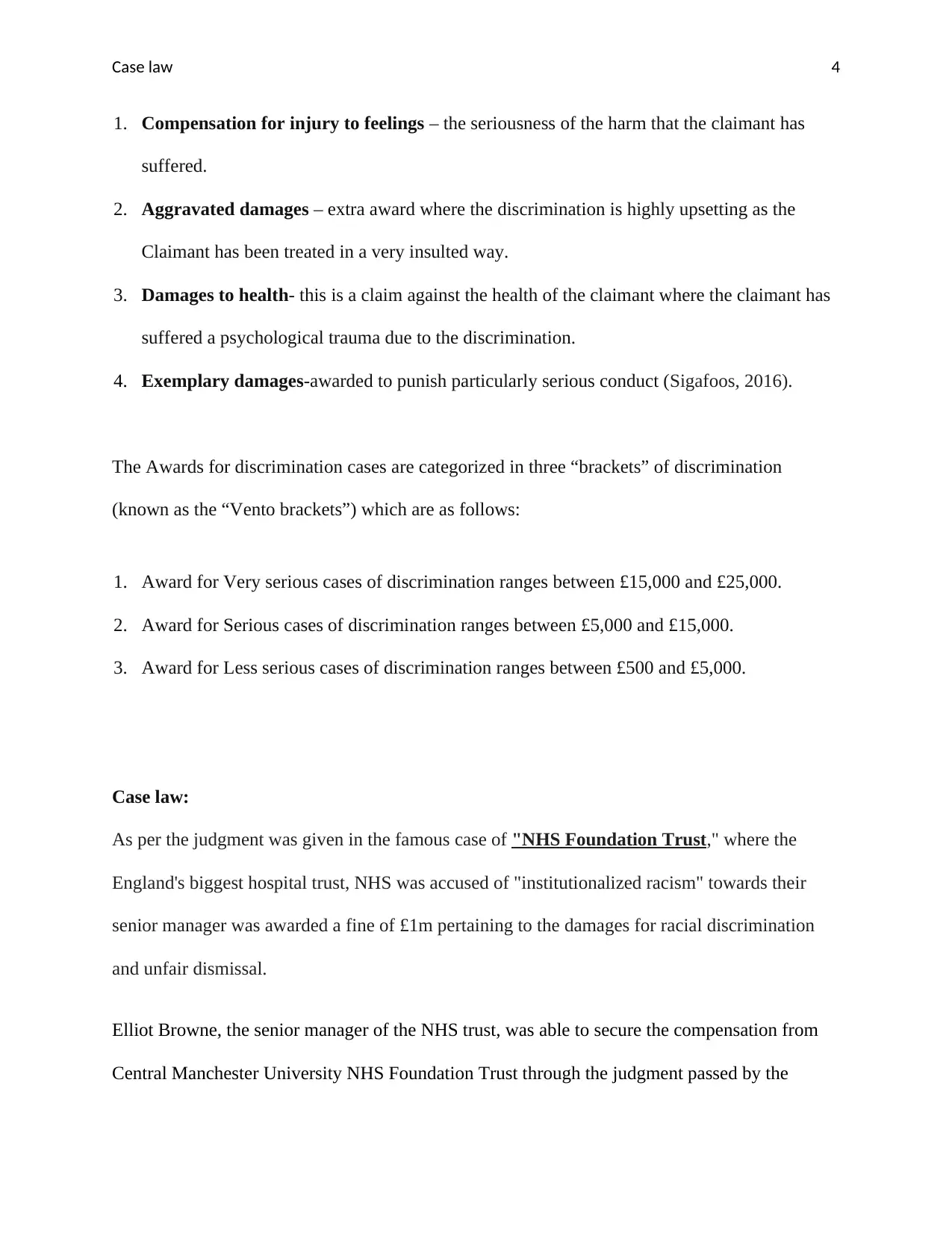
Case law 4
1. Compensation for injury to feelings – the seriousness of the harm that the claimant has
suffered.
2. Aggravated damages – extra award where the discrimination is highly upsetting as the
Claimant has been treated in a very insulted way.
3. Damages to health- this is a claim against the health of the claimant where the claimant has
suffered a psychological trauma due to the discrimination.
4. Exemplary damages-awarded to punish particularly serious conduct (Sigafoos, 2016).
The Awards for discrimination cases are categorized in three “brackets” of discrimination
(known as the “Vento brackets”) which are as follows:
1. Award for Very serious cases of discrimination ranges between £15,000 and £25,000.
2. Award for Serious cases of discrimination ranges between £5,000 and £15,000.
3. Award for Less serious cases of discrimination ranges between £500 and £5,000.
Case law:
As per the judgment was given in the famous case of "NHS Foundation Trust," where the
England's biggest hospital trust, NHS was accused of "institutionalized racism" towards their
senior manager was awarded a fine of £1m pertaining to the damages for racial discrimination
and unfair dismissal.
Elliot Browne, the senior manager of the NHS trust, was able to secure the compensation from
Central Manchester University NHS Foundation Trust through the judgment passed by the
1. Compensation for injury to feelings – the seriousness of the harm that the claimant has
suffered.
2. Aggravated damages – extra award where the discrimination is highly upsetting as the
Claimant has been treated in a very insulted way.
3. Damages to health- this is a claim against the health of the claimant where the claimant has
suffered a psychological trauma due to the discrimination.
4. Exemplary damages-awarded to punish particularly serious conduct (Sigafoos, 2016).
The Awards for discrimination cases are categorized in three “brackets” of discrimination
(known as the “Vento brackets”) which are as follows:
1. Award for Very serious cases of discrimination ranges between £15,000 and £25,000.
2. Award for Serious cases of discrimination ranges between £5,000 and £15,000.
3. Award for Less serious cases of discrimination ranges between £500 and £5,000.
Case law:
As per the judgment was given in the famous case of "NHS Foundation Trust," where the
England's biggest hospital trust, NHS was accused of "institutionalized racism" towards their
senior manager was awarded a fine of £1m pertaining to the damages for racial discrimination
and unfair dismissal.
Elliot Browne, the senior manager of the NHS trust, was able to secure the compensation from
Central Manchester University NHS Foundation Trust through the judgment passed by the
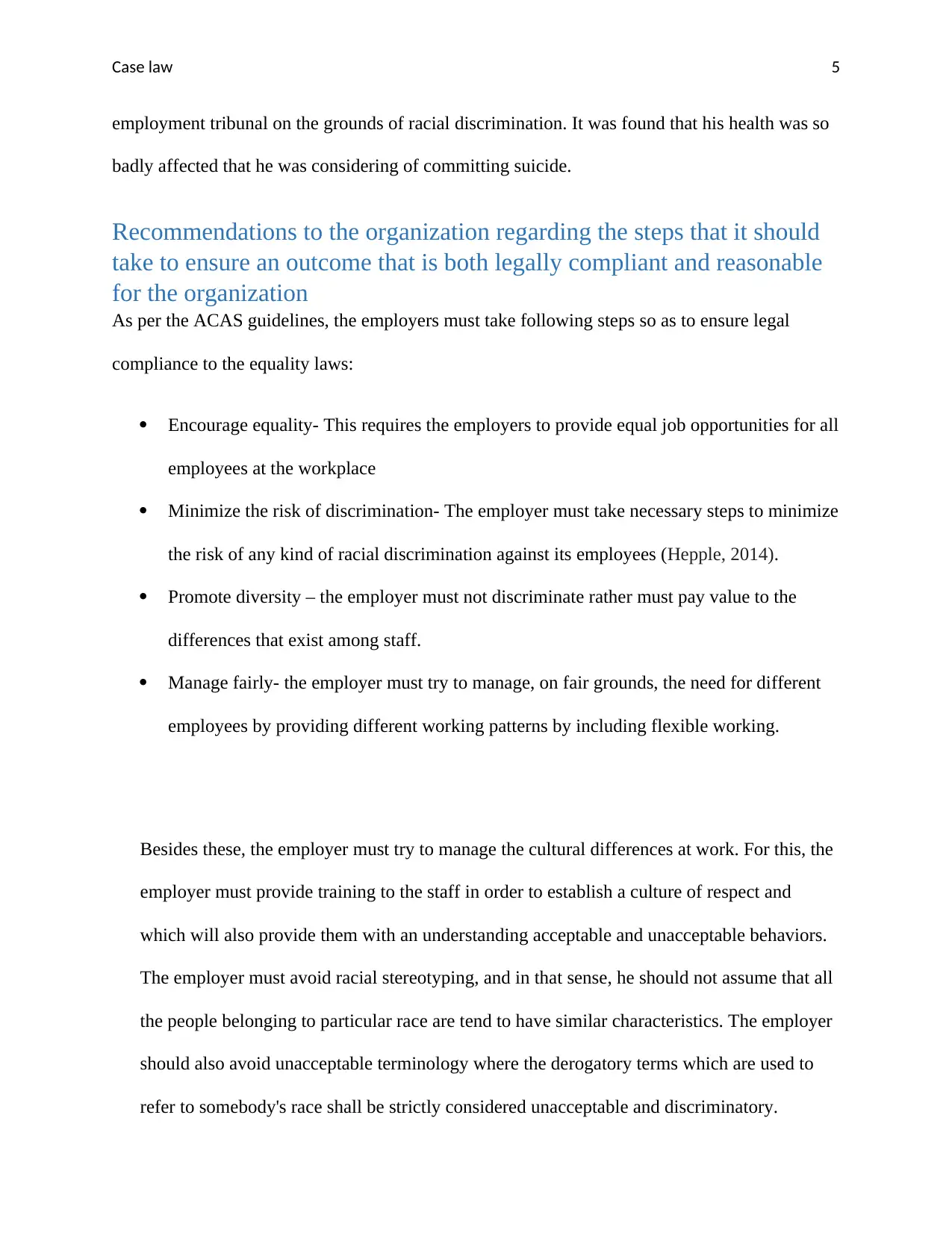
Case law 5
employment tribunal on the grounds of racial discrimination. It was found that his health was so
badly affected that he was considering of committing suicide.
Recommendations to the organization regarding the steps that it should
take to ensure an outcome that is both legally compliant and reasonable
for the organization
As per the ACAS guidelines, the employers must take following steps so as to ensure legal
compliance to the equality laws:
Encourage equality- This requires the employers to provide equal job opportunities for all
employees at the workplace
Minimize the risk of discrimination- The employer must take necessary steps to minimize
the risk of any kind of racial discrimination against its employees (Hepple, 2014).
Promote diversity – the employer must not discriminate rather must pay value to the
differences that exist among staff.
Manage fairly- the employer must try to manage, on fair grounds, the need for different
employees by providing different working patterns by including flexible working.
Besides these, the employer must try to manage the cultural differences at work. For this, the
employer must provide training to the staff in order to establish a culture of respect and
which will also provide them with an understanding acceptable and unacceptable behaviors.
The employer must avoid racial stereotyping, and in that sense, he should not assume that all
the people belonging to particular race are tend to have similar characteristics. The employer
should also avoid unacceptable terminology where the derogatory terms which are used to
refer to somebody's race shall be strictly considered unacceptable and discriminatory.
employment tribunal on the grounds of racial discrimination. It was found that his health was so
badly affected that he was considering of committing suicide.
Recommendations to the organization regarding the steps that it should
take to ensure an outcome that is both legally compliant and reasonable
for the organization
As per the ACAS guidelines, the employers must take following steps so as to ensure legal
compliance to the equality laws:
Encourage equality- This requires the employers to provide equal job opportunities for all
employees at the workplace
Minimize the risk of discrimination- The employer must take necessary steps to minimize
the risk of any kind of racial discrimination against its employees (Hepple, 2014).
Promote diversity – the employer must not discriminate rather must pay value to the
differences that exist among staff.
Manage fairly- the employer must try to manage, on fair grounds, the need for different
employees by providing different working patterns by including flexible working.
Besides these, the employer must try to manage the cultural differences at work. For this, the
employer must provide training to the staff in order to establish a culture of respect and
which will also provide them with an understanding acceptable and unacceptable behaviors.
The employer must avoid racial stereotyping, and in that sense, he should not assume that all
the people belonging to particular race are tend to have similar characteristics. The employer
should also avoid unacceptable terminology where the derogatory terms which are used to
refer to somebody's race shall be strictly considered unacceptable and discriminatory.
⊘ This is a preview!⊘
Do you want full access?
Subscribe today to unlock all pages.

Trusted by 1+ million students worldwide
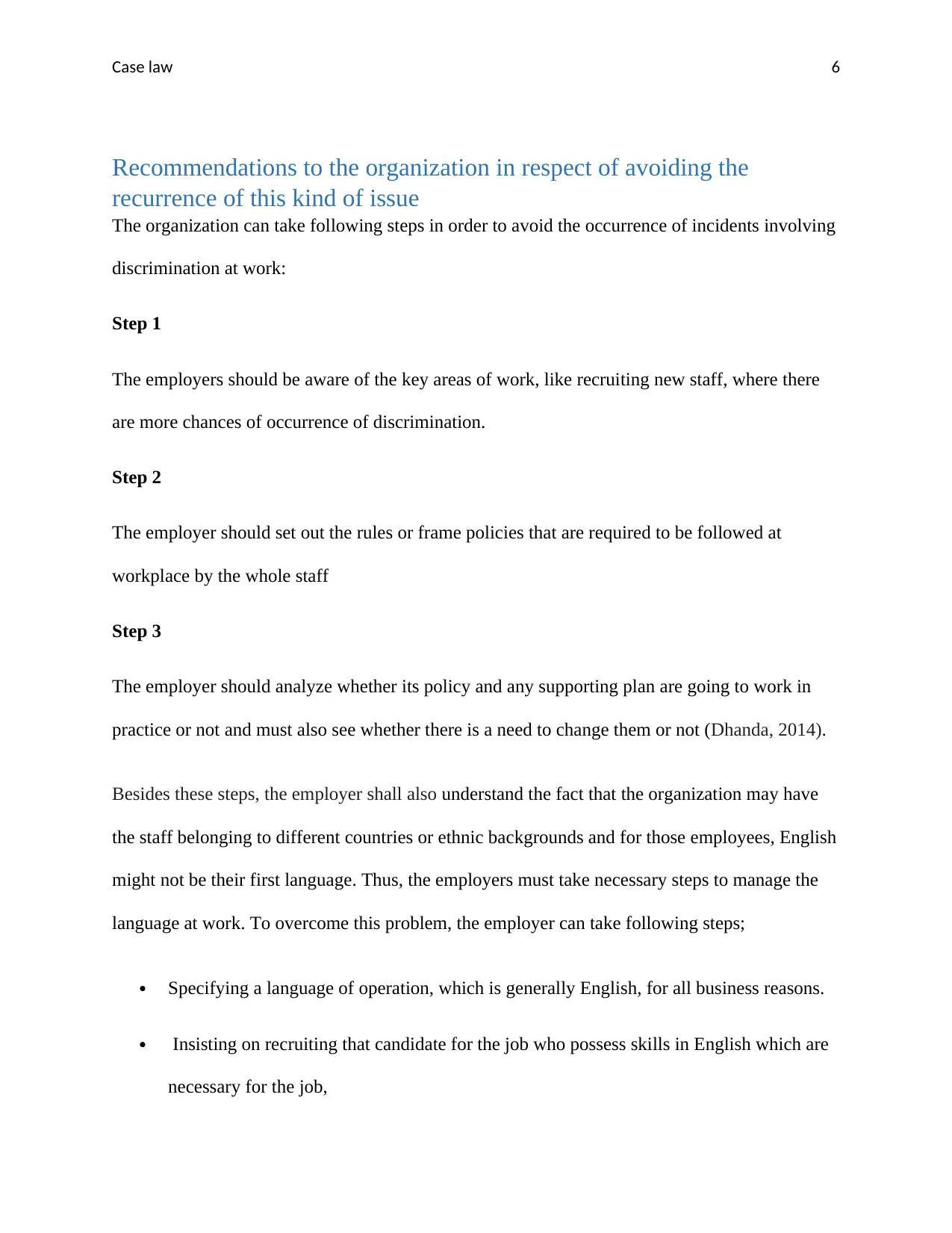
Case law 6
Recommendations to the organization in respect of avoiding the
recurrence of this kind of issue
The organization can take following steps in order to avoid the occurrence of incidents involving
discrimination at work:
Step 1
The employers should be aware of the key areas of work, like recruiting new staff, where there
are more chances of occurrence of discrimination.
Step 2
The employer should set out the rules or frame policies that are required to be followed at
workplace by the whole staff
Step 3
The employer should analyze whether its policy and any supporting plan are going to work in
practice or not and must also see whether there is a need to change them or not (Dhanda, 2014).
Besides these steps, the employer shall also understand the fact that the organization may have
the staff belonging to different countries or ethnic backgrounds and for those employees, English
might not be their first language. Thus, the employers must take necessary steps to manage the
language at work. To overcome this problem, the employer can take following steps;
Specifying a language of operation, which is generally English, for all business reasons.
Insisting on recruiting that candidate for the job who possess skills in English which are
necessary for the job,
Recommendations to the organization in respect of avoiding the
recurrence of this kind of issue
The organization can take following steps in order to avoid the occurrence of incidents involving
discrimination at work:
Step 1
The employers should be aware of the key areas of work, like recruiting new staff, where there
are more chances of occurrence of discrimination.
Step 2
The employer should set out the rules or frame policies that are required to be followed at
workplace by the whole staff
Step 3
The employer should analyze whether its policy and any supporting plan are going to work in
practice or not and must also see whether there is a need to change them or not (Dhanda, 2014).
Besides these steps, the employer shall also understand the fact that the organization may have
the staff belonging to different countries or ethnic backgrounds and for those employees, English
might not be their first language. Thus, the employers must take necessary steps to manage the
language at work. To overcome this problem, the employer can take following steps;
Specifying a language of operation, which is generally English, for all business reasons.
Insisting on recruiting that candidate for the job who possess skills in English which are
necessary for the job,
Paraphrase This Document
Need a fresh take? Get an instant paraphrase of this document with our AI Paraphraser
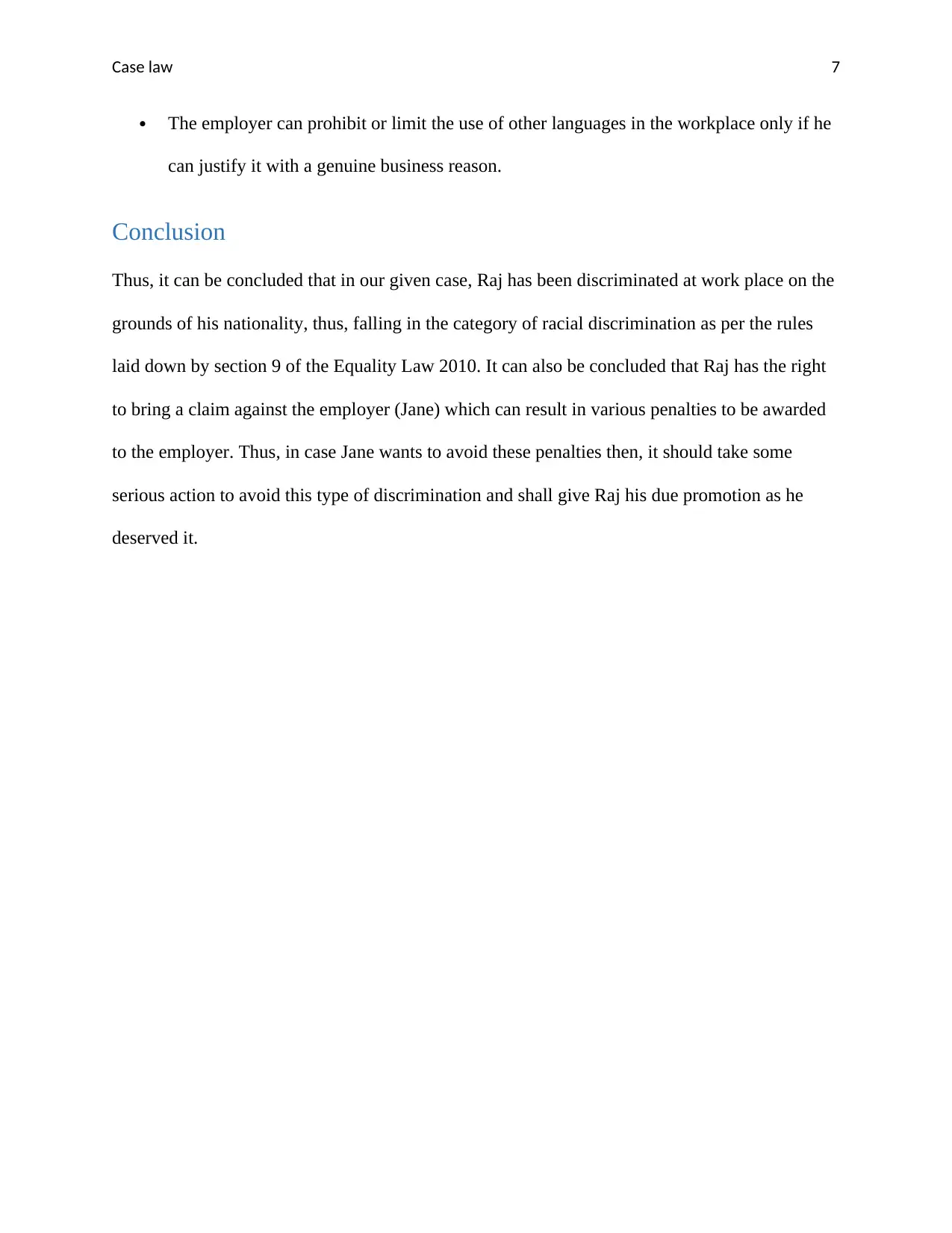
Case law 7
The employer can prohibit or limit the use of other languages in the workplace only if he
can justify it with a genuine business reason.
Conclusion
Thus, it can be concluded that in our given case, Raj has been discriminated at work place on the
grounds of his nationality, thus, falling in the category of racial discrimination as per the rules
laid down by section 9 of the Equality Law 2010. It can also be concluded that Raj has the right
to bring a claim against the employer (Jane) which can result in various penalties to be awarded
to the employer. Thus, in case Jane wants to avoid these penalties then, it should take some
serious action to avoid this type of discrimination and shall give Raj his due promotion as he
deserved it.
The employer can prohibit or limit the use of other languages in the workplace only if he
can justify it with a genuine business reason.
Conclusion
Thus, it can be concluded that in our given case, Raj has been discriminated at work place on the
grounds of his nationality, thus, falling in the category of racial discrimination as per the rules
laid down by section 9 of the Equality Law 2010. It can also be concluded that Raj has the right
to bring a claim against the employer (Jane) which can result in various penalties to be awarded
to the employer. Thus, in case Jane wants to avoid these penalties then, it should take some
serious action to avoid this type of discrimination and shall give Raj his due promotion as he
deserved it.
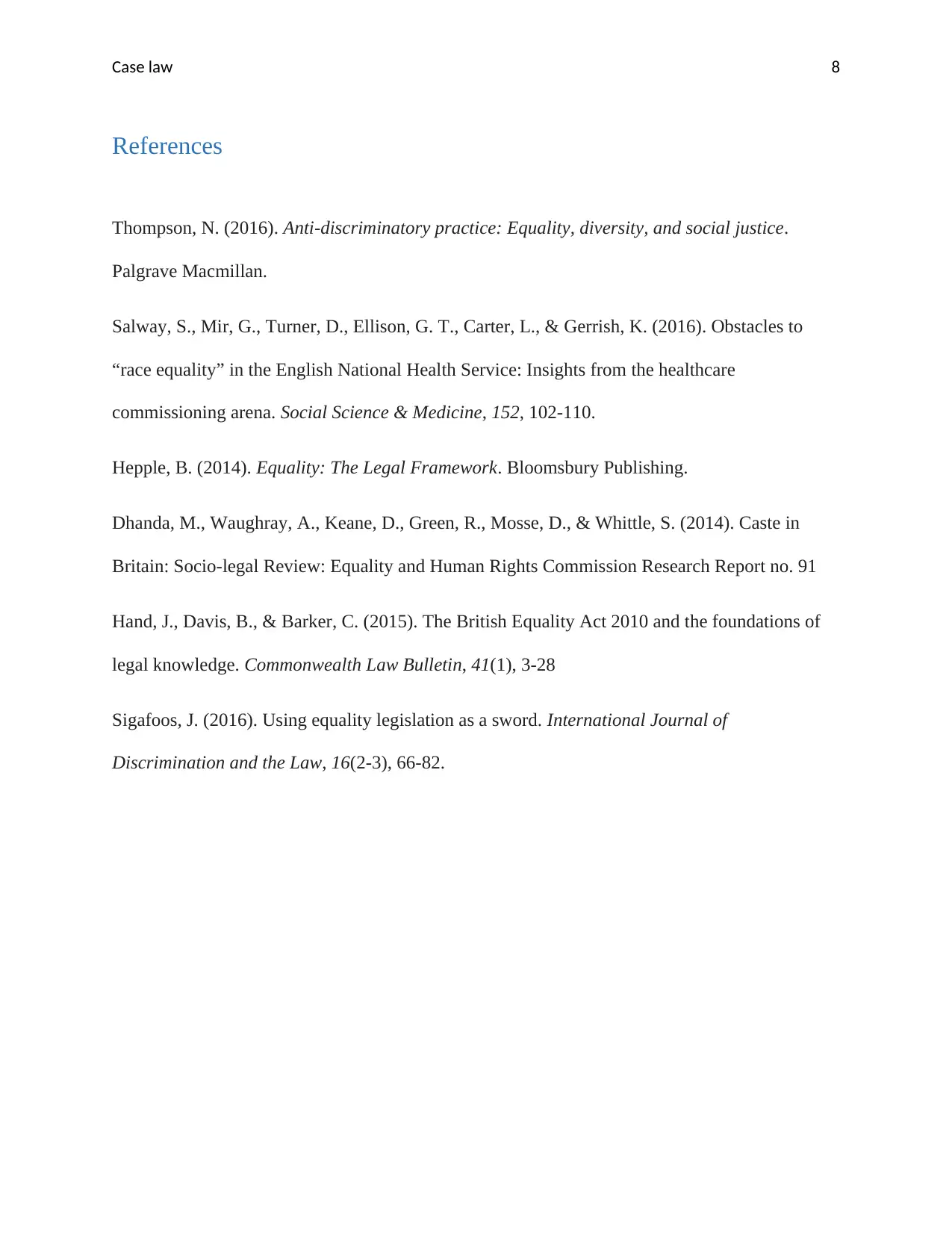
Case law 8
References
Thompson, N. (2016). Anti-discriminatory practice: Equality, diversity, and social justice.
Palgrave Macmillan.
Salway, S., Mir, G., Turner, D., Ellison, G. T., Carter, L., & Gerrish, K. (2016). Obstacles to
“race equality” in the English National Health Service: Insights from the healthcare
commissioning arena. Social Science & Medicine, 152, 102-110.
Hepple, B. (2014). Equality: The Legal Framework. Bloomsbury Publishing.
Dhanda, M., Waughray, A., Keane, D., Green, R., Mosse, D., & Whittle, S. (2014). Caste in
Britain: Socio-legal Review: Equality and Human Rights Commission Research Report no. 91
Hand, J., Davis, B., & Barker, C. (2015). The British Equality Act 2010 and the foundations of
legal knowledge. Commonwealth Law Bulletin, 41(1), 3-28
Sigafoos, J. (2016). Using equality legislation as a sword. International Journal of
Discrimination and the Law, 16(2-3), 66-82.
References
Thompson, N. (2016). Anti-discriminatory practice: Equality, diversity, and social justice.
Palgrave Macmillan.
Salway, S., Mir, G., Turner, D., Ellison, G. T., Carter, L., & Gerrish, K. (2016). Obstacles to
“race equality” in the English National Health Service: Insights from the healthcare
commissioning arena. Social Science & Medicine, 152, 102-110.
Hepple, B. (2014). Equality: The Legal Framework. Bloomsbury Publishing.
Dhanda, M., Waughray, A., Keane, D., Green, R., Mosse, D., & Whittle, S. (2014). Caste in
Britain: Socio-legal Review: Equality and Human Rights Commission Research Report no. 91
Hand, J., Davis, B., & Barker, C. (2015). The British Equality Act 2010 and the foundations of
legal knowledge. Commonwealth Law Bulletin, 41(1), 3-28
Sigafoos, J. (2016). Using equality legislation as a sword. International Journal of
Discrimination and the Law, 16(2-3), 66-82.
⊘ This is a preview!⊘
Do you want full access?
Subscribe today to unlock all pages.

Trusted by 1+ million students worldwide

Case law 9
Paraphrase This Document
Need a fresh take? Get an instant paraphrase of this document with our AI Paraphraser

Case law 10
1 out of 11
Related Documents
Your All-in-One AI-Powered Toolkit for Academic Success.
+13062052269
info@desklib.com
Available 24*7 on WhatsApp / Email
![[object Object]](/_next/static/media/star-bottom.7253800d.svg)
Unlock your academic potential
Copyright © 2020–2025 A2Z Services. All Rights Reserved. Developed and managed by ZUCOL.




